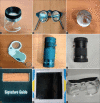Changes in visual acuity using low vision devices in patients with Leber hereditary optic neuropathy: A retrospective study
- PMID: 36727327
- PMCID: PMC10228962
- DOI: 10.4103/ijo.IJO_1130_22
Changes in visual acuity using low vision devices in patients with Leber hereditary optic neuropathy: A retrospective study
Abstract
Purpose: This study was conducted to estimate the visual acuity improvement in patients with Leber hereditary optic neuropathy (LHON) with the help of low vision devices (LVDs) and to analyze the types of distant and near LVDs prescribed to the patients with LHON.
Methods: A retrospective case review of 74 subjects with LHON who were referred to a low vision care clinic at a tertiary eye center from 2016 to 2019 were recruited. The reason for referral was assessed from the patients' electronic medical records (EMR). Demographic data of the patients, visual acuity status, type of LVD prescribed, and visual acuity improvement with LVD were documented.
Results: Out of 74 patients, 91.9% (n = 68) were male, and the median age of patients was 21 (16) years. A 4× monocular telescope was prescribed for 2.7% of patients (n = 2) and SEETV binocular telescope for 1.4% (n = 1) was advised for distance. The most commonly prescribed near LVD was the 6× cutaway stand magnifier for 22 patients (29.7%). Four patients (5.4%) were prescribed with Notex, the most commonly prescribed non-optical LVD. Niki CCTV (12.2%, n=9) was the most commonly prescribed assistive device. The subjects were divided into three groups based on age: group I consisted of those <18 years of age, group II 18-40 years, and group III >40 years for the interpretation of visual improvement. There was a statistically significant improvement (group I: P < 0.001, group II: P < 0.0001, group III: P < 0.003) in near vision with help of LVDs in all three groups.
Conclusion: The use of LVDs and rehabilitation can help patients with LHON to lead a better life and will be more beneficial.
Keywords: Leber hereditary optic neuropathy; low vision care clinic; low vision devices; visual impairment.
Conflict of interest statement
None
Figures
References
-
- Kirkman MA, Korsten A, Leonhardt M, Dimitriadis K, Ireneaus F, Klopstock T, et al. Quality of life in patients with Leber hereditary optic neuropathy. Investig Ophthalmol Vis Sci. 2009;50:3112–5. - PubMed
-
- Spruijt L, Kolbach DN, Rene F, Plomp AS, Bauer NJ, Smeets HJ, et al. Influence of mutation type on clinical expression of Leber hereditary optic neuropathy. Am J Ophthalmol. 2006;141:676–82. - PubMed
-
- Sadun AA, La Morgia C, Carelli V. Leber's hereditary optic neuropathy. Curr Treat Options Neurol. 2011;13:109–17. - PubMed
-
- Sundaramurthy S, SelvaKumar A, Ching J, Dharani V, Sarangapani S, Yu-Wai-Man P. Leber hereditary optic neuropathy—new insights and old challenges. Graefes Arch Clin Exp Ophthalmol. 2021;259:2461–72. - PubMed
MeSH terms
LinkOut - more resources
Full Text Sources


